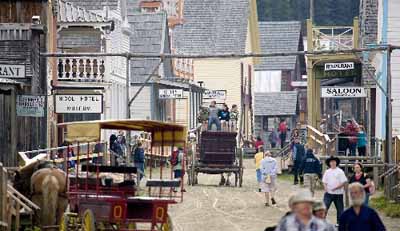Barkerville National Historic Site of Canada
Barkerville, British Columbia

General view
(© Parks Canada/Parcs Canada 2009.)
Address :
Barkerville, British Columbia
Recognition Statute:
Historic Sites and Monuments Act (R.S.C., 1985, c. H-4)
Designation Date:
1924-06-04
Dates:
-
1862 to 1865
(Construction)
-
1868 to 1868
(Significant)
-
1869 to 1885
(Significant)
Other Name(s):
-
Barkerville
(Designation Name)
-
Cariboo Gold Fields
(Other Name)
Research Report Number:
2008-CED-SDC-033
Plaque(s)
Existing plaque: Barkerville, British Columbia
A search for the source of placer gold found on lower parts of the Fraser River led to discoveries of lode mines in the Cariboo, of which the richest part, Williams 'Creek, is said to have yielded $19,000,000. As a centre of population in the 1860's, the gold fields were the catalyst for the economic and political development of the colony of British Columbia. They attracted miners from around the world and stimulated the growth of trade and agriculture. Economic difficulties resulting from a decline in gold yield after 1865 promoted a desire for the union of the colonies of British Columbia and Vancouver Island.
Description of Historic Place
Barkerville National Historic Site of Canada is located on Williams Creek in eastern British Columbia. The historic town was founded in 1862 after the discovery of significant gold deposits in the Cariboo gold fields, but was destroyed by fire in 1868. Constructed almost immediately on the ruins of the first, the second Barkerville began a gradual decline, surviving with reduced mining operations and the maintenance of government offices. The restoration and rebuilding of the town in the late-1950s was initiated with the intension of returning Barkerville to its 1869-1885 state. The townsite, surrounded by huge pits and ditches from 19th century gold mining, marks the northern terminus of the Cariboo Wagon Road, and contains within its boundaries the Chee Kung Tong Building National Historic Site of Canada. Official recognition refers to the boundary of the Barkerville Historic Town at the time of designation.
Heritage Value
Barkerville was designated a national historic site of Canada in 1924 because: it was the centre of the Cariboo gold fields which were the catalyst for the economic and political development in British Colombia; it was the terminus of the great wagon road from Yale, completed in 1865.
The town of Barkerville on Williams Creek began to grow around 1862 after the discovery of significant gold deposits in the Cariboo gold fields. The gold fields were the catalyst for economic and political development in British Colombia. The increased prosperity of Barkerville was facilitated by the Cariboo road, or Great Wagon Road, constructed by the colony of British Columbia between 1862 and 1865. The 650 kilometre-long road greatly improved access to the Cariboo gold fields, beginning at Yale, a major steam port and ending at Barkerville, amidst the gold fields. The road was part of a plan to boost the economy by drawing traffic away from American entrepreneurs, by vastly reducing shipping costs to the mines and by encouraging commerce and settlement in the interior. Unfortunately, the town of Bakerville was almost completely destroyed by fire in 1868, leaving only four buildings intact. A second Barkerville was immediately constructed on the ruins of the first town. While the community continued to survive based on periodic mining excitement and the maintenance of government offices, Barkerville started to decline and unused houses fell into disrepair or were demolished.
British Columbia’s centennial in 1958 provided a catalyst for the restoration of the town. The provincial government created Barkerville Historic Provincial Park and reconstructed the town to mirror its appearance during the 1869-1885 period. This period was chosen because the Cariboo gold fields and Great Wagon Road to Barkerville fostered economic and political development in British Colombia. It also marks a significant date in British Columbia’s history with the completion of the Canadian Pacific Railway.
Sources: Historic Sites and Monuments Board of Canada, Minutes, 1924, November 2008.
Character-Defining Elements
Key elements that contribute to the heritage character of the site include: its location in eastern British Colombia, at the heart of the historic mining district; its setting on the banks of Williams Creek; the planned, design, and layout of the buildings; the buildings in their original form, construction and materials; the raised wooden boardwalk; the integrity of any surviving or as yet unidentified archaeological remains relating to the 1862 Barkerville and the 1868 reconstruction, which may be found within the site in their original placement and extent; its relationship with the Chee Kung Tong National Historic Site of Canada and the Cariboo Wagon Road National Historic Event of Canada; the viewscapes across Williams Creek.